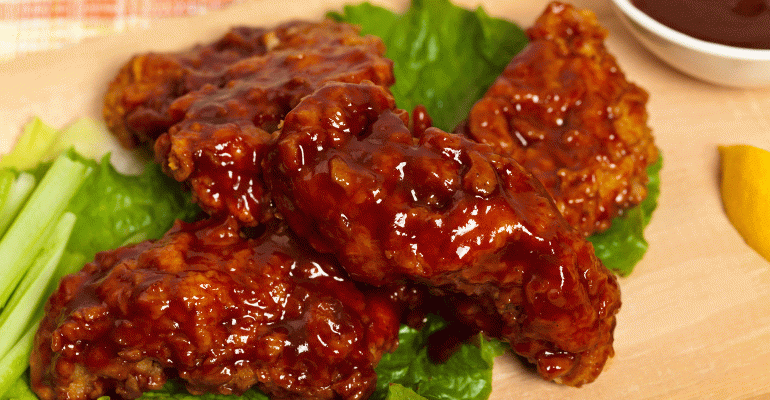A spike in bone-in chicken-wing prices has put operators who specialize in wings in a difficult position: pass on increased costs to customers and risk losing them, or try to convince bone-in wing fans to switch to less expensive boneless wings, which are typically chicken breast meat formed into a wing-like shape.
“If you’re a true bone-in aficionado, you’re not going to switch [to boneless],” said NPD analyst Bonnie Riggs. “You’ll likely trade down in portion size or go to someone who’s better priced.”
According to new data about the habits of chicken wing purchasers from The NPD Group, consumers’ appetite for wings, especially bone-in, is growing. Forty-five percent of those surveyed purchased chicken wings from a restaurant at least once in the past year, up from 43 percent a year ago.
However, NPD found that most consumers are dissatisfied with the affordability of wings and their ability to purchase them more often. While they like the product, only 33 percent of bone-in purchasers and 34 percent of boneless purchasers rated affordability and their ability to purchase wings often as excellent.
“This tells me that raising prices too much will put [operators] at risk,” Riggs said. “Affordability ratings will likely go down as prices escalate.”
But that doesn’t mean the chicken wing is totally out of the coop.
Riggs said there is an opportunity to appeal to dual purchasers, those who sometimes order bone-in wings and sometimes order boneless. Of consumers who purchase wings, about a third are dual purchasers, while a third purchase bone-in only and 38 percent purchase boneless only, according to NPD’s Checkout Tracking.
Among those most inclined to order boneless wings are Millennials, or adults between the ages of 18 to 24, NPD found.
Riggs also suggested that there is an opportunity to appeal to bone-in buyers with value adds, split pricing or promotions, the latter of which has proven to be successful in creating stronger demand for wings.
“They are going to have to move away from bone-in promotions,” Riggs said. “What else can [operators] do to make it more compelling to pay the price.”

Winning wing strategies
Amid rising chicken wing prices, some operators are just winging it, while others are executing what they hope will be winning wing strategies. Executives from Cincinnati-based Buffalo Wings & Rings and Atlanta-based Wing Zone discussed how they are positioning both bone-in and boneless wings for maximum appeal.
Buffalo Wings & Rings organizes task force
In late summer, when bone-in wing prices were starting to rise, Buffalo Wings & Rings established a “wing task force.” It was important for the chain because wings make up 30 percent of the menu. The task force developed tactics to nudge customers toward purchasing boneless wings.
“Boneless are so much cheaper than bone-in, so you want to try to shift them to boneless, but it’s not an easy strategy,” said Nader Masadeh, CEO of Buffalo Wings & Rings. “Consumers come with specific ideas; habits are not easy to break.”
Among the tactics they’ve executed include training waitstaff to upsell the quality of the chain’s boneless wings, which are hand-cut from the tenderloin and breaded to order. The chain also created innovative boneless wing preparations, such as wings that are fried, grilled, tossed in honey and topped with garlic.
“The adventurous eaters, those willing to try something else, these are the ones you want to try to shift,” Masadeh said.
The efforts have proven successful, and the chain reported a 2-3 percent customer shift to boneless wings.
“When face-to-face with consumers, that’s the best selling tool,” Masadeh said. “Captivate them at the decision point.”

Wing Zone jazzes up boneless wings
Flavored boneless wing specials and a free boneless wing day are some of the ways Wing Zone is tempting customers to go boneless.
“Everyone in our category is trying to move customers to boneless,” said Matt Friedman, founder and CEO of Wing Zone. “As a restaurant, the profitability of boneless is way greater.”
With 70 restaurants in the college and university market, Wing Zone sells about 50 percent bone-in and 50 percent boneless wings. But just a few years ago, the mix was two-thirds bone-in and one-third boneless. Part of the shift is that boneless wings are “less work, lower priced,” and part is age-related, with those under 30 years old ordering boneless more often, Friedman said.
Buoying boneless orders of late is the chain’s flavored boneless wings, such as the recently added Korean BBQ and the upcoming Lemon Zest Dry Rub and Chipotle BBQ. Wing Zone also hopes to convert more customers to boneless wings by letting them try them for free, no purchase necessary, during Free Boneless Day on Dec. 6.
“We think it’s important to keep these things fresh, innovative,” Friedman said.
Despite the shift to more boneless wings sales, Friedman said consumers will pay a premium for an “original,” or bone-in, wing as long as operators are upfront about the pricing.
“We are testing different ways of doing [original wings],” he said.
The preparations being explored include smoking and grilling, as well as offering jumbo-sized wings.





